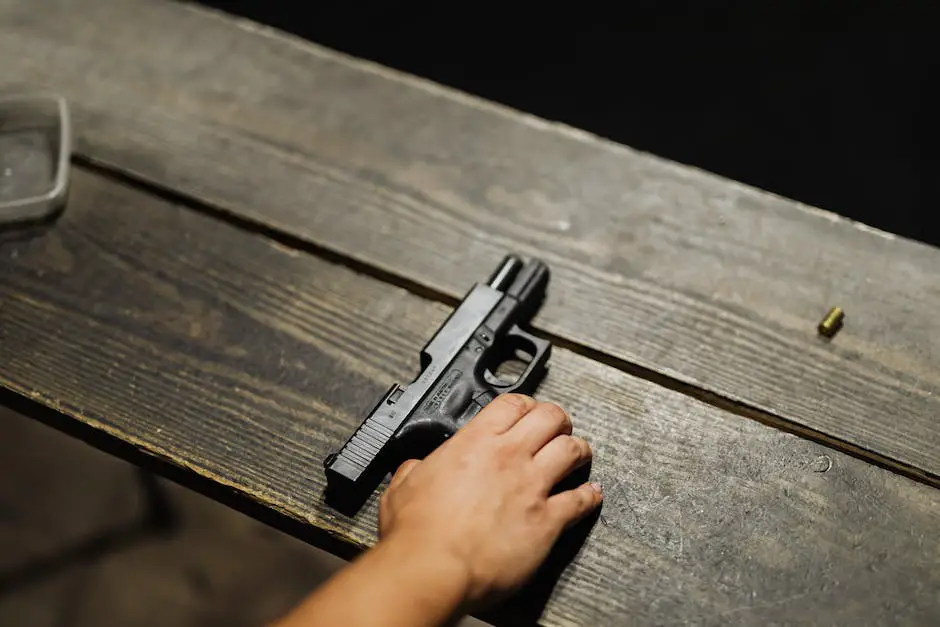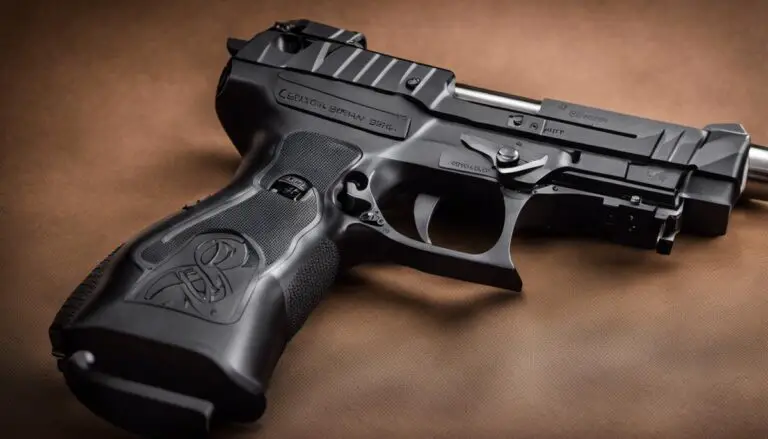There is a world of robust exploration and depth of knowledge to be found within the realm of firearm enthusiasts, particularly when it comes to engaging discussions about SAR 9 pistols. A popular choice among hobbyists and professionals alike, the SAR 9, while generally reliable, has seen its share of issues that owners and users should better understand for improved firearm experience. This in-depth analysis covers a wide range of topics, from concerns with the trigger mechanism to the impact of material quality and accuracy issues. Moreover, it delves into the maintenance difficulties faced by SAR 9 users, making it an essential read for anyone keen on becoming more proficient in understanding and handling this firearm.
Problematic Trigger Mechanism in SAR 9
Delving into the SAR 9’s Trigger Mechanism: User Concerns Uncovered
Unleashing an unprecedented level of functionality and practicality, the SAR 9 has become an essential part of every firearm enthusiast’s collection. But like any other piece in the dynamic realm of firearms, it’s not without its own idiosyncrasies. The trigger mechanism, in particular, has sparked a significant degree of concern among users. So, let’s unravel this aspect a bit and decipher what makes it a hot topic of debate in the gun world.
First, let’s delve into the basic structure of the SAR 9’s trigger. It’s part of a striker-fired system, which essentially means it utilizes a spring-loaded firing pin. The long trigger pull, required to compress the striker spring to the breaking point, can indeed come as a surprise, especially for those accustomed to the crisp, short reset of other models. This distinctive characteristic might require a bit of adjustment, which can be seen as a concern for some.
Moving on, the SAR 9’s trigger action has been described as ‘spongy’ by several users. As the name suggests, a ‘spongy’ feeling often depicts a lack of definitive engagement and release points, which can subtly affect the accuracy and shooting experience. It’s worth emphasizing, though, that this might not be a universal concern; a ‘spongy’ feeling might even suit some shooters’ style. Yet, it’s certainly a point worth noting for any potential SAR 9 owner.
The noticeable travel distance before the break is another component attracting mixed opinions. This feature, although beneficial for safety purposes, can appear as an unnecessary extension to many. Long travel distance might create a feeling of inconsistency or unpredictability. Users often underline this element as a minor, yet noteworthy concern, potentially affecting their overall comfort and accuracy during shooting sessions.
Then, there’s the relatively substantial trigger reset. For users habituated to short or medium resets, it might come as a bit of a curveball. The requirement to let the trigger fully extend before the subsequent shot might require an adaptation period from users. This element might seem out of sync with many shooter’s rhythm and timing, raising another area of concern.
In essence, the concerns surrounding the SAR 9’s trigger are not monumental deal-breakers, but they are indeed valid points that potential users should consider. Just as every coin has two sides, so does the SAR 9’s trigger mechanism. While its peculiarities can be seen as a challenge by some, others might see it as a unique feature characterizing this specific firearm model.
To put it simply, the SAR 9’s trigger mechanism is as unique as they come. It is this uniqueness that imparts a distinct identity to this semiautomatic pistol in the vast firearm universe. Recognizing the concerns related to its trigger mechanism should help users make an informed decision and, when required, adapt their shooting style accordingly.

Photo by dancristianpaduret on Unsplash
Issues with SAR 9 Accuracy
The Impact of Accuracy Issues on the SAR 9’s Shooting Performance
Dating back nearly 140 years, the legendary Turkish brand SAR, Sarsilmaz, has unraveled a masterpiece in the form of SAR 9. A sturdy, reliable semi-automatic pistol that has swept the firearms world off their feet with its excellent ergonomics and exceptional manufacturing. Yet, there’s always room for perfection, and while this gun offers a unique driving experience, the accuracy reliant on the trigger mechanism has flared up in several discussions within the gun enthusiast circles.
One primary issue flagged frequently relates to the SAR 9’s accuracy is associating with the trigger pull weight. The SAR 9’s trigger pull averaging around 5.5 pounds, can affect one’s shooting performance. Specifically, this can result in a jerking motion as the gun is fired, leading to a misleading bullet trajectory from your original aim. The excess weight in the trigger pull might necessitate greater effort and hand strength, affecting the trigger control—a factor that doesn’t go unnoticed for those passionate on delivery precision shots.
Furthermore, when talking accuracy, we have to address the issue of overtravel. Overtravel is the extent to which the trigger continues to move back after the gun has fired. Now, it’s pretty common among pistols, but with the SAR 9’s considerable travel distance before the trigger break, it could lead to an unnecessary slide, effectively hampering your accuracy.
Another noteworthy point is the anticipation recoil, which gets its significance even in a SAR 9 gun. Because of the seemingly spongy action of the trigger, a shooter might prematurely react to the expected recoil, which can cause them to push the muzzle down. Hence, the bullets might not hit right where you want them to, resulting in a significant impact on the shooting accuracy.
The last but hardly the least, another potential influence deals with the trigger reset length. As a shooter, you are likely to train yourself in fast reset to engage multiple targets. SAR 9’s substantial reset can make it rather challenging, therefore influencing your shooting performance indirectly by slowing down the rate of fire.
No firearm is perfect, and while the SAR 9 provides an unforgettable experience to gun enthusiasts worldwide, overcoming these challenges makes one an even better shooter. Recognizing accuracy issues is the first step towards refining our shooting skills and understanding our firearm better, strengthening that bond between man and machine. The SAR 9, with all these challenges, remains a unique piece for every enthusiast’s collection and a worthy companion to master their shooting skills.

Material Quality of SAR 9 Guns
Digging deeper into the world of SAR 9 handguns, it’s impossible to overlook the influence of the material quality on its performance and durability. Materials aren’t just about aesthetics – their quality directly affects how well your firearm operates and how long it lasts.
The body of the SAR 9 is constructed from a blend of polymers. The choice of material is by no means random. Polymers are known for their ability to resist harsh environmental factors, as well as their lightweight, an essential feature for a standard service pistol. The presence of polymers doesn’t compromise the strength of the firearm – on the contrary, it infuses the SAR 9 with great durability.
Then comes the slide of the SAR 9, forged from solid steel. With the wonders of steel, you get excellent resistance to wear and tear, adding to the long lifespan of your firearm. These material choices reflect a striking balance between strength and weight, making the SAR 9 a reliable sidearm for various conditions.
Yet, durability is not the only factor at play here. An equally important question arises – how do these materials impact the performance of the SAR 9? The combination of lightweight polymers and robust steel results in a firearm that’s both manageable and durable, which translates directly to performance.
With less weight to manage, the shooter has more control over the firearm, reducing the likelihood of anticipation recoil. A firearm that’s too heavy could disrupt aim stability, thus diverting the bullet from its intended path. The lightweight nature brought by polymers enhances the accuracy potential of the SAR 9.
Meanwhile, a robust firearm guarantees a consistent performance. Poor quality materials can undergo deformation after repeated use, altering the firearm’s structural integrity and negatively impacting its performance. The steel slide of the SAR 9 ensures sustained reliability, granting shooters the confidence in firing shot after shot with consistent precision.
In the grand scheme of things, the SAR 9 thanks to its superior material quality, delivers a commendable performance and boasts of longevity. It handles the pressures of continued use, braves harsh environmental conditions, and still maintains consistent accuracy. The materials used in the SAR 9 aren’t chosen haphazardly – they are strategically planned to craft a firearm that’s reliable, durable, and effective. The SAR 9 owners not only take pride in the distinct trigger mechanism but also in its exceptional reliability and performance, credited largely to the quality of materials used.

Photo by liferondeau on Unsplash
SAR 9 Maintenance Difficulties
Let’s delve further into the various aspects of SAR 9 firearm maintenance. Beyond the well-known issues of the trigger’s feel and function, there are other less talked about challenges such as grip angle, feed reliability, and cleaning regimen that can significantly affect the shooting experience with a SAR 9.
The grip angle, which demands a higher angle of wrist break, could end up affecting overall consistency and comfort during prolonged shooting sessions. This may not be significant for casual shooters, but for enthusiast-level hobbyists seeking top-tier performance from their SAR 9, it may require getting accustomed to.
Talking about feed reliability, the SAR 9 generally offers reliable cartridge feed. Yet, users might encounter occasional failures to feed when using certain brands of ammunition. This is not a shortcoming of the SAR 9 per se, but rather an issue of compatibility between ammo and firearm. Choosing the right ammunition, preferably one recommended for use with the SAR 9, can help in minimizing such issues.
When it comes to cleaning, the SAR 9 requires meticulous attention. Regular cleaning and oiling lie at the heart of maintaining the SAR 9’s performance, due to the potential for dust and grime to accumulate within its unique trigger mechanism and polymer body. A decent cleaning kit and a disciplined maintenance schedule go a long way in ensuring your firearm’s longevity.
Another key aspect is the issue of slide release. Hobbyists should note that the SAR 9’s slide does not always return to firing position as fluidly as it should, especially when a round remains in the chamber. Practicing quick and efficient manual slide resets during live-fire exercises can help counteract this.
Finally, there’s the issue of sight alignment. Now, the out-of-the-box sights on the SAR 9 are perfectly functional but might not meet the standards of some seasoned shooters. There is room for improvement in terms of both speed and precision, and many shooters resort to aftermarket sights to achieve better shooting accuracy with their SAR 9.
Remember, each firearm is a unique combination of strengths and quirks, and the SAR 9 is no different. While these maintenance issues might seem daunting at first, they offer ample opportunities for an engaged hobbyist to truly understand and master their firearm. Embrace these challenges as integral parts of your journey towards becoming a seasoned SAR 9 enthusiast. Let’s seal this knowledge with a universal truth in the firearms world: A well-maintained SAR 9, is a reliable SAR 9. Happy shooting, folks!

Mastery of a firearm isn’t achieved by simply understanding the working mechanisms, but also by gaining a comprehensive understanding of its potential pitfalls and how to manage them. The goal of this comprehensive narrative was to shed light on some of the common issues SAR 9 users encounter, from its trigger mechanism to accuracy, material quality, and maintenance challenges. Enhancing one’s skill in managing these issues not only stands to significantly improve their firearm experience but also prolongs the lifespan and reliability of their SAR 9. With persistence and patience, most of these problems are indeed surmountable, leading to a more enjoyable and veritably safer firearm handling experience.

Born in rural Texas, Logan has been a passionate gun enthusiast from a young age, influenced by his family’s deep-rooted tradition in hunting and sport shooting. He has carved out a niche as an authoritative voice in the firearms community, writing extensively about gun safety, hunting techniques, and the latest advancements in firearm technology.

